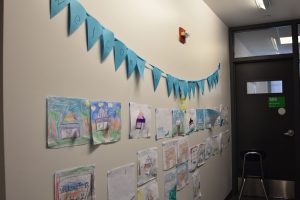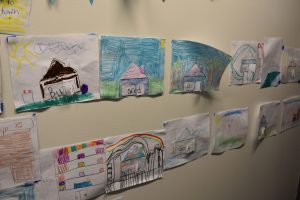 In a town created by Red Cluster students, all of the houses are occupied by different types of syllables.
In a town created by Red Cluster students, all of the houses are occupied by different types of syllables.
Words such as bit, hop, and bed have taken up residence in Syllable Town, and it’s all to help students learn about the six types of syllables and their characteristics.
This multisensory activity was designed by Reading Specialist Kristi Evans as her Red Cluster reading group recently started to learn about syllable types.
Ms. Evans said Gaynor reading specialists explicitly teach the six syllable types as part of their Orton-Gillingham instruction because the syllables represent the overarching structure of the English language.
She also said that vowels are tricky for students, so this provides them with a kinesthetic strategy to find out what the vowels say in a given word.
“We want to provide our students with the tools they need to independently attack unknown single and multisyllabic words,” she said. “So instead of relying on guessing, this strategy helps students divide a longer word into meaningful chunks, and from there, blend the syllables together to read the word.”
In order to learn two of the syllable types — open and closed — the reading group created multisensory houses and placed them in Syllable Town.
The houses demonstrate what happens to the vowel sound based on when the door of each house goes from being closed to open. Based on the syllable type, the vowel sound is either short or long.
“For example, the word hip is a closed syllable, because there’s a consonant at the end and the vowel is short,” Ms. Evans said. “When we open the door, the syllable becomes an open syllable and the vowel sound is long (in this case, it sounds like ‘hype’), because when a word or syllable ends in a vowel, the vowel says its name.”
As the students advance in their reading, they will learn more syllable types and will eventually learn all six.
Through the activity of opening and closing doors, students understand why some words have long vowels and short vowels, which Ms. Evans said is a key principle to the Orton-Gillingham approach.
“With the Orton-Gillingham approach, we are always asking the students the question, why?” she said. “For example, ‘Why is the o in the word so a long vowel?’ or ‘Why is the e in the word bed a short vowel?’ In analyzing and knowing the syllable types, our students can confidently answer the questions.”*
*Answers to the questions posed by Ms. Evans:
- The o in the word so is long because the word so is an open syllable.
- The e in the word bed is short because the word bed is a closed syllable.



